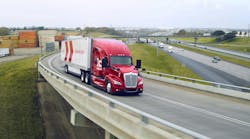Using technology to clear carriers and freight across borders is a lot harder than it looks, according to Michael Dinning, division chief of the Dept. of Transportation's Volpe Transportation Research Center in Cambridge, MA.
And sometimes it's even entertaining. As part of a DOT delegation visiting an Italian seaport, Dinning got an up-close-and-personal reminder of how even a little human error can unhinge security technology at the border.
“The port had designed a sensor package that fit into a boom array under which a truck and trailer would drive,” he relates. “They were really proud of this system because it would take only seconds for it to scan an entire truck and locate explosives, radioactive material, etc. So we went over there for a demonstration, to look at its possibilities for our ports and borders.”
But the driver of the test truck — obviously unfamiliar with the security apparatus — proceeded to plow full speed into the sensor boom, smashing it to pieces.
“The boom had been set too low,” Dinning explains, destroying million of dollars worth of equipment. “It proved, rather dramatically, that no technology is any good if the policies, and especially the training for the humans using it, aren't there to make it work like it should.”
But other tests have, thankfully, been more successful, Dinning notes. For example, making sure trailer locks and seals have unique serial numbers ensures loads are not tampered.. Satellite monitoring and location systems have also proved useful.
“We're finding tracking and tracing systems can be best used to spot anomalies,” Dinning points out. “If a particular route usually takes three hours to cover and it ends up taking 12, with two unscheduled stops, that's valuable information,” he says. “It also allows for the electronic creation of ‘safe havens’ where drivers should stop to prevent cargo tampering and theft, and then monitor their use by satellite tracking.”


